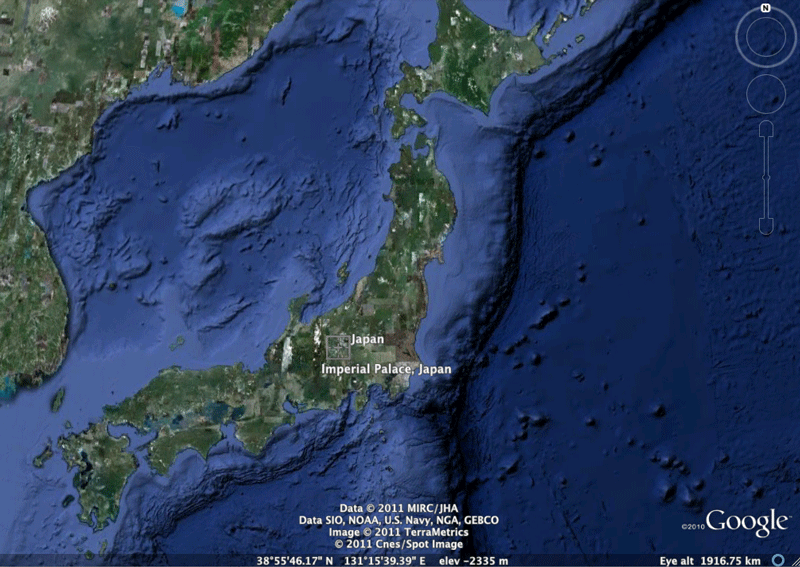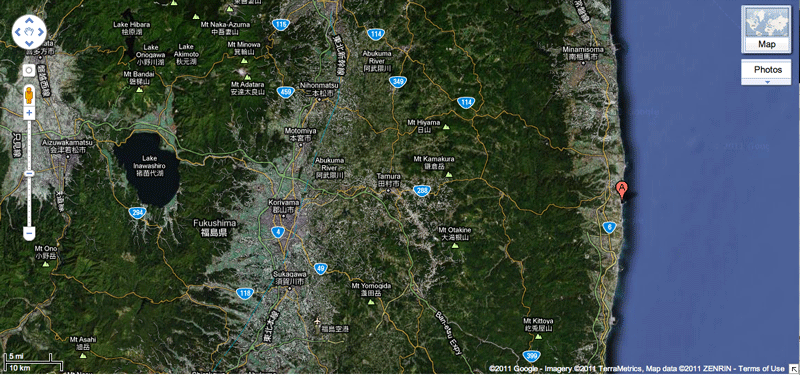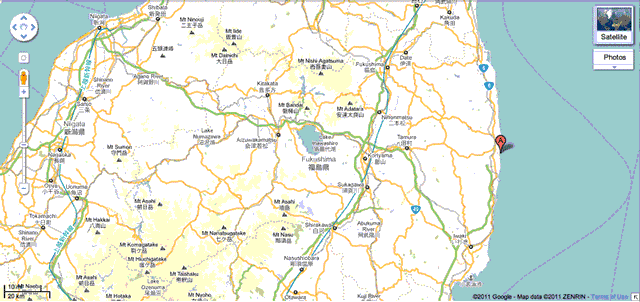April 15, 2011
Fukushima Ring

I was thinking of the impact of the Fukushima Ring, the fifty mile safety zone centered on the Fukushima Daiichi Nuclear power plant in Japan.

So I drew the ring on a GoogleMap to see how big it is.
Pretty impressive. In scale to the island, it's a sizable chunk of land. But it is a bite sized chunk after all, since the plant was beside the ocean. Assuming it can be contained, and this is a certain assumption, radiation harmful to life will emanate in rings of less deadly zones, ultimately to a radius that is deemed harmless to human beings. Shipping will have to navigate around this new maritime hazard. Hopefully, sea life will be unaffected with the proviso that Japan will be able to contain the damage sufficiently enough, and there is no reason to think otherwise.

Of course, the methods of graphic representation can enhance or belie the impact of the Ring. This is a huge chunk of land, but it is located in a relatively remote part of Japan (yes, with such a land mass, one could say that nothing is remote, but even so...). With a radius of 50 miles, the length of the boundary on land is about 300 miles. I typed in "300 mile fence" into Google search and got this. Subsequent searches yielded this and of course, this. So, such a feat is possible within these extents. Will Japan build a wall, the Fukushima Wall? Surely the government has a responsibility to delineate this boundary for the public at large. What could such a fence or wall or (I resort to the thesaurus) or enclosure or barricade or stockade or palisade... look like?
Designs of the ring, a wall.
I remember a school assignment during my years teaching architecture at Woodbury University in Burbank. It was the very same kind of nuclear hazard barrier. The challenge was to design exactly this kind of structure. That assignment specified the context of nuclear waste storage in Nevada. Students immediately dove into the emotional fear and drama of the subject. I remember many designs over designed, some with trenchant figuration, others trying to embody the spirit of the threat of radiation in complex and dizzying compositions of structure. Armchair designs in pipe smoke floated from the visiting jurists at the critique. Just as I heard yesterday when describing the Fukushima Ring to my pals and when asked what they would suggest for the design of the wall, came fanciful and humorous and rascally sarcastic ideas. A huge dome. Scenes from scifi movies were evoked. A massive ringed pile of bones. Should it be invisible? Should it be monumental? It was a lark of a design problem then, and here we are with something concrete, real and present.
What would you suggest for the design of the Fukushima Wall?

The towns of Tamura and Iwaki are within this circumference. Will they have to be abandoned? I couldn't find much online about topographic elevations above sea level, but there was a map of Tamura that noted a crest of a mountain at 700 feet, as far as I could tell. The Hollywood sign here in Los Angeles is over twice that high. So the best we might have here are hills that separate the valley dotted by Fukushima, Koriyama and Sukagawa. These hills will provide a bit of a shadow for these communities, but not by much, apparently. What Japan loses are the summer resort and vacation destinations along the coast.
...for the next, hundred years? I googled:
Over the long term, the big threat to human health is cesium-137, which has a half-life of 30 years.At that rate of disintegration, John Emsley wrote in ?Nature?s Building Blocks? (Oxford, 2001), ?it takes over 200 years to reduce it to 1 percent of its former level.?
It is cesium-137 that still contaminates much of the land in Ukraine around the Chernobyl reactor. In 1986, the plant suffered what is considered the worst nuclear power plant accident in history.
Scary stuff. I got confused between the numbers thirty and two hundred. How many years will it be until the site can recover?
I googled:Most worrisome of all is plutonium-239 ? for a number of reasons. First of all, the vast majority of a fuel rod is made of plutonium, which means there's just more of it in play. What's more, says Helfand, "It's extraordinarily toxic." Plutonium exposure usually comes from inhalation rather than ingestion, so it's mostly associated with lung cancer. What's more, plutonium's half life is 24,000 years, which means anything released in Fukushima today could be around at dangerous levels for up to half a millon years.
Whoa.
Maybe many thousands of years?
Well.
Maybe that would be an indication as to the question of the proper degree of monumentality of the design?
They could physically remove affected material over time and cleanse the site with radiation detection equipment. (Do scientists still use geiger counters, or is it another technology with another name?) Imagine a design for a handheld vacuum cleaner, one merged with a geiger counter. Or a Roomba, something cuddly that sucks up radioactive particles. A sip, a puff in reverse, a slurp of hot soup. The little robot could waddle around sucking up radioactive particles here and there all day and by night it vomits it's stomach into a hazard disposal bag and goes to sleep. [End Digression] Is it possible to purify Fukushima eventually? I'll believe this is so until I encounter evidence to the contrary. Right now, for me, the time frame to sweat out the danger is between 30 and 24,000 years.
Then I read this, and I am slightly reassured. There's a lot of hysteria out there, better to get your attention, dear reader.

What is the reality of the radiation zone in Fukushima? Just how dangerous is it? How close can human beings live near it?
And finally in this missive, a remarkable video of two guys (Tetsuo Jimbo for videonews.com) trying to see how close they could come to the stricken reactor. Amazing, mournful stuff. It's sad to see the animals running feral. Time 09:15 makes me want to cry. Seriously.
While I am grateful for these two knuckleheads journalists for pulling off such a stunt report, notice that these guys just drove a car right up to the plant without being stopped, or at least this is what the video suggests. I'm glad that they informed the world about the current situation at Fukushima, but it might be good to limit free access to the site in the future.
Like a wall of some kind.
*
*
*
The long-term scope of Fukushima's leaks, then, still depends upon not only how much radiation escapes, but also what kind. If the majority of the radioactivity is short-lived, it may be possible to simply wait for it to decay away. Iodine-131, one of the major isotopes detected from Fukushima, will be largely gone after 10 half-lives (80 days total)?decayed to less than 0.1 percent of the original. Cesium (Cs-137), on the other hand, has a 30-year half-life. High concentrations of Cs-137 could force Japan to cordon off and clean up the affected areas, as happened at Chernobyl?a process that could take years to decades, depending on the level of contamination. Buildings contaminated with short-lived nuclides may be reoccupied after a brief wait, while those with longer-lived radioactivity may require either cleanup or demolition. That's a decision for another day.A sarcophagus.The same goes for the fate of the plant. The last of Three Mile Island's residual fuel was removed from the reactor in 1993, but the structures will remain standing for years, until radiation levels drop to the point where work can be done there safely. At Chernobyl, the reactor was encased in a concrete sarcophagus to contain the radioactivity. And at Fukushima, we just don't know yet what actions will be taken to contain the radioactivity, but they will likely include a combination of cleanup, eventual demolition of the affected reactors, and building temporary containment structures such as the Chernobyl sarcophagus.
Design ideas, anyone?
Posted by Dennis at April 15, 2011 3:22 PM
Leave a comment